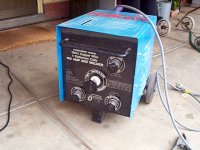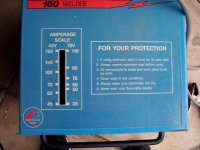Netlist said:I suppose there is a decent fuse in there?
Don't know what the Aussie plugs look like but why would you want to change it?
Nice supply for an amp?

/Hugo
ahh, sorry.. the 15amp plug has a larger earth pin so ya can't plug it into a 10amp socket... as far as I can tell, there's no fuse...
ahh, sorry.. the 15amp plug has a larger earth pin so ya can't plug it into a 10amp socket... as far as I can tell, there's no fuse... lol not outside anyway....
Thats a saftey precuation purposly built so you dont go plugging it into a 10amp socket. A normal house socket supplies upto 9amps in Aust, if you draw more then the 9amps, you run a very high risk of fire as the cabling in the house will melt. You need to get an electriction in to wire up a 15amp socket, with the apropiate wiring from the meter box.
Trev
ace3000_1 said:
Thats a saftey precuation purposly built so you dont go plugging it into a 10amp socket. A normal house socket supplies upto 9amps in Aust, if you draw more then the 9amps, you run a very high risk of fire as the cabling in the house will melt. You need to get an electriction in to wire up a 15amp socket, with the apropiate wiring from the meter box.
Trev
I know its a saftey precaution, but I'm never going to be running it flat out, that was my question.... connect it to a 10 amp outlet, and run it at 65 or whatever percent of its maximum output.... I'm not PAYING someone to install a 15amp fuse for an arc welder that cost me nothing, and that I'll probably never use
Cal Weldon said:I am finding this interesting.
I knew about European power being 240V (which makes sense) but I didn't know down under you have 9 amp circuits. Is that also 120 or is it 240.
Here in Canada we have 120V 15 amp.
Curious Cal
its 240volts at... well.. the outlets are 10amps..... not sure what ace3000 was saying about 9 amps.... heaters, toasters, etc often draw the maximum current, 2400watts.. hmm...
its 240volts at... well.. the outlets are 10amps..... not sure what ace3000 was saying about 9 amps.... heaters, toasters, etc often draw the maximum current, 2400watts.. hmm...
9/10 amps max, normally the cable is rated at a max of 9amps continuos where as the socket is rated an amp higher for saftey purposes. Ive drawn 10 amps through a standard socket before, it got quite warm and i was forever blowing out the fuses in the meter box because it was right on the limit. What happends if i put a 15amp fuse in? boom, house fire after time.
Toasters draw about 500w - 1000w max unless you own a soup kitchen and have a toaster thats suited for an army. Heaters that draw over 2200w require a 240v 15amp power supply.
After the 240v 10amp circut here in aust, we have the 240v 15amp circut, after that its 3 phase being 440v rated from 20amps upto about 200amps which you can imagine is industrial use. In the engineering shop i used to work in we had 2x 200amp 3 phase supplys that actually had to be conected to a seperate high amperage cable on the power line which is only found in industrial areas. For a suburbian area normally you can get the 3 phase power only upto about 40amps max.
All power that goes to the meter box in aust is 440v. The meter box then distributes the power in the house at 240v for all power points and light circuts, only an electric oven and an electric hot water system have different circuts being either 440v 3 phase for the oven, and/or a higher amperage 240v normally being 15amps for the hot water system.
To get an optional 3 phase circut conected into a house ( for a workshop) in aust in a modern home normally they have to change the power cable running to the house to a higher amperage cable, though in most cases this isnt neseseary unless you want to draw high amps, and/or you have a long cable run to the house from the power line. They then either do 1 of 2 things, put in a seperate meter box just for a 3 phase line ( dependant of current ratings), or use the existing with a new power board.
In europe most places have 230v, in spain its 230v rated at 10amps continuous max.
In America and canada the amperage is higher due to the fact the voltage is lower, typically 110v - 120v @15amps. At the end of the day apliances in the usa compaired to those in europe and aust all use the same power, the only difference being is the power supply to break the power down. Its just a shame we all have meters
Another point i will add is that the longer the cabled circut is in a house, the less amps it can handle, and thats why most exstention cables you buy over 10meters long are made out of 15amp cable with the 10amp pluggs stuck on the end of it. Get a 1 meter peice of string, tie a 1kg weight on the end of it, ok it holds, now get a 3m peice of string and see if it holds with the same weight, bang, it breaks, its the same with power. My piont is, the wiring in a house is very long and it gives us limits. Most of us who do our own wiring in our house daisy chain power points together, people then think they have 2x 9amp power supplies, when actually you dont, you have 2x 4.5 - 5amp rated power sockets as you cant draw 18amps on a rated 9/10amp single line safley. If you wer to draw 2x9amps = 18amps of power there will be a bang as your overloading the circut, fortunatley we have fuses and breakout circuts to protect us from this or we would soon be up in smoke. And thats why we hire an electrician to tap into the back of the meter box, or the back bone cable in the house to wire our house safley.
Skinny, if you tap into your brothers room and draw 15amps this doesnt mean its safe to do so, he would have to have all apliances off, and depending on your cable length your lines maybe under rated. Power Cables are normally rated at their spec upto a distance of 15 - 20meters. Wheather your welder is on full pelt or not, it would be atlaest safe to power it with the required 15amps as stated by the manufacturer. How do you know it doesnt draw 15amps at half power? from a few welders that ive looked in they used a big resistor to control the power output thus drawing its rated current draw all of the time, the others wer switches to change the winding in the coils.
Trev
thankyou ace3000 for your input.... but I think I'll choose to ignore it..  (don't worry, you can't be held responsible)
(don't worry, you can't be held responsible)
do arc welders generally have some protection for if you short out the output? I guess it would have to.
also, welding currents/voltages... whats best? I have 45 or 70 volts, at adjustable currents... I read somewhere that most small arc welders are 40 volts. is higher voltage therefore better?
do arc welders generally have some protection for if you short out the output? I guess it would have to.
also, welding currents/voltages... whats best? I have 45 or 70 volts, at adjustable currents... I read somewhere that most small arc welders are 40 volts. is higher voltage therefore better?
ace3000_1 said:
Skinny, if you tap into your brothers room and draw 15amps this doesnt mean its safe to do so, he would have to have all apliances off, and depending on your cable length your lines maybe under rated. Power Cables are normally rated at their spec upto a distance of 15 - 20meters. Wheather your welder is on full pelt or not, it would be atlaest safe to power it with the required 15amps as stated by the manufacturer. How do you know it doesnt draw 15amps at half power? from a few welders that ive looked in they used a big resistor to control the power output thus drawing its rated current draw all of the time, the others wer switches to change the winding in the coils.
Trev
did I mention my brother is out over half the time? and when he's not home, all that is powered up in his room is a clock radio?
do arc welders generally have some protection for if you short out the output? I guess it would have to.
No they dont, if you had a fuse for the output circut then you wouldnt be able to weld, because a arc welder is just a power supply that we short out on purpose.
also, welding currents/voltages... whats best? I have 45 or 70 volts, at adjustable currents... I read somewhere that most small arc welders are 40 volts. is higher voltage therefore better?
Higher voltages are used for thick plate, normally 10mm and up, that also goes with the amperage, the thinner the plate is the lower the voltage and amperage.
Trev
did I mention my brother is out over half the time? and when he's not home, all that is powered up in his room is a clock radio?
LOL, are you sure there isnt any grow lights in the wardrobe?
ace3000_1 said:
No they dont, if you had a fuse for the output circut then you wouldnt be able to weld, because a arc welder is just a power supply that we short out on purpose.
Higher voltages are used for thick plate, normally 10mm and up, that also goes with the amperage, the thinner the plate is the lower the voltage and amperage.
Trev
I didn't say a FUSE, I said short circuit protection... I should have said current limiting.. but anyway
I didn't say a FUSE, I said short circuit protection... I should have said current limiting.. but anyway see, my dad made an adjustable powersupply with a selectable current limiting.... .5amps, 1 amp, and 2.5amps (I think) so even if you dead short it, it still only gives that much current....
No short circut protection because your shorting the welder out on purpose to create the arc. There should be thermal protection but thats it, the psu your dad made is basically the same as your welder, you controll your current via the dial on the front, there isnt to my knewlege any over current protection on the input for over drawing power cos normally you would use a breaker with it in the fuse box.
Trev
- Status
- This old topic is closed. If you want to reopen this topic, contact a moderator using the "Report Post" button.
- Home
- Member Areas
- The Lounge
- I now have one of these.....

